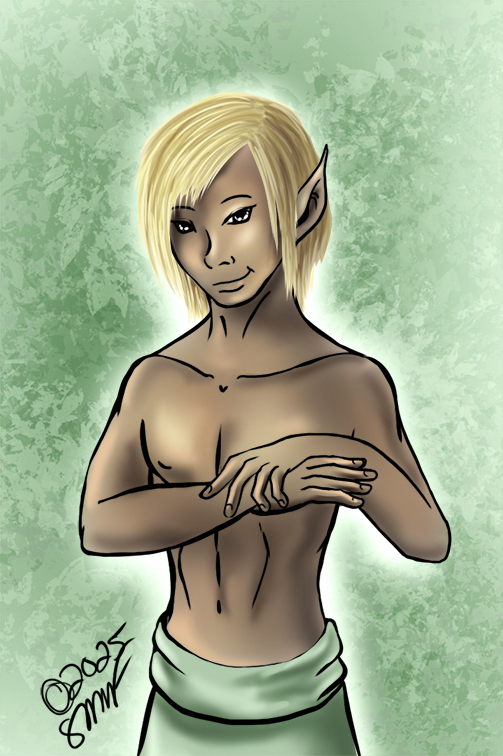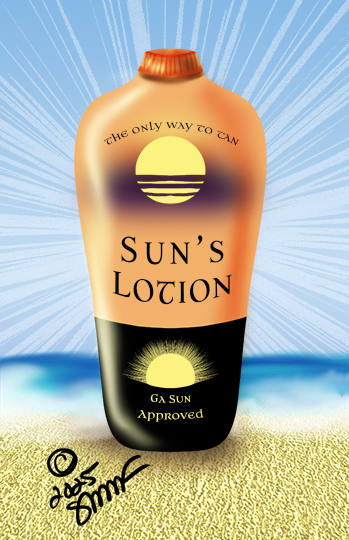Sun's Tan
I'm writing this short bit about Sun worship because Lorgan asked. Since I was born and raised in a Sun temple, I suppose I do know a thing or two about the Sun Tan.
Sun acolytes cherish a good tan. They see sunbathing as a religious experience that brings them closer to Sun. The deeper the suntan, the more spiritual the person, for they have spent more time than others in his presence.
Most Sun temples provide accommodation to tan, as it is one of the more holy acts any follower can perform. It is not without its downsides, however. These downsides are why many in the upper priesthood use bottled tan, heavy makeup, or even magic enhancement to produce the perfect tan.
Acolytes are supposed to do it the natural way, since it's a form of prayer--spend a lot of time in the sun.
Sun's Tan
by our guest writer,Vantra
In this Research Document:
all images by Shade Melodique
unless otherwise stated
unless otherwise stated
The Why of It
The upper priesthood of Sun temples typically have darker tans, as befitting their station. Those from warmer climates with naturally dark skin are considered Sun-touched. They often hold positions of power within the temple and conduct the most important ceremonies.
Hair bleached by sunbathing is a sign of blessing as well. From ancient times to the present, acolytes who could not lighten their hair while sunbathing would artificially bleach their tresses, ranging from a deep gold to a soft amber. Too light, however, and that was considered more in the Realm of the Syimlin of Light, so completely white tresses are discouraged. There needed to be some gold remaining.
Why? Ga Son, the Syimlin of Sun (whose name means The Sun), has tanned skin and golden hair. The idea was to look as much like him as possible.
Of note: My mother thinks it's funny, that Sun priests harp on a deep tan and bleached hair, but not on other physical attributes, like his lean muscles. She says most would fail that achievement.
Tanning
For optimal tans, acolytes would sit outside during the midday meal, tanning while they ate (or, if it were during the colder seasons, inside a warmed room with a glass roof and walls). When the day became too hot, they would return indoors and use lotions to soothe their skin and make certain they did not burn.
Modern adherents often use lotions to prevent burning, but traditionalists believe that one must monitor their skin on their own, without outside interference. They also deride the use of sun googles or other protection.
And yes, traditionalists tend to be elfines and nymphs (they live centuries, as elfines and nymphs are wont to do, so it's expected that they think back to their younger years and the worship trends popular then. I sometimes wonder, if they paid attention to anything that went on in between their birth and the modern day).
The ill effects of sun tanning are the reason the Sun temples have strong healing wings. Healers developed all manner of preventative lotions and cures for those afflicted by various ailments, and are the Talin leaders in cancer research.
The healing wings are not restricted to Sun adherents, and the Water Sun Temple (yes, it's a nymph bastion, which explains the name) has an entire hospital attached to it.
Of course, tanning led to all manner of ills. Skin cancers were the primary bane of ancient Sun acolytes, with some going into hiding because of the damage done to their skin. Loss of sight plagued many an elder, and others developed an allergy to sunlight from which they never recovered. Those poor souls were cast out of the cult, and drifted to Moon’s, where they could worship a celestial body without the pressure to further damage themselves.
And the pressure was immense. Sun, being the eldest syimlin, and perhaps the creator of Sensour, had a strict following who hated deviating from prescribed ritual. This led to the Sun cult being considered the most fundamental of syimlin followers, and led to the smallest worshipper counts during the time syimlin were considered myth, nothing more.
Kasoris
Only fanatics joined the Sun cult—until a hundred years previous, when the Flayn Monarchy tried to invade Sensour. The syimlin fought alongside mortals, and when Death took the field, the invaders perished. The realization that syimlin existed energized languishing cults, and ancient religious ideals found their way into modern worship practices. The return to tanning as a holy act infused Sun temples—until my mother, Kasoris, became high priestess of Spiral Sun.
Kasoris hated the tanning rituals. She saw them as causing more harm than good, and while emulating a deity was commendable, she did not think Ga Son ever wanted to harm his followers by forcing them to take on his appearance. Older clergy, especially the elfines and nymphs, disliked a human stomping all over their cherished traditions and attempted to change the religious by-laws to force all practicing adherents to conduct ritual tanning. It had been that way forever, after all, and they saw no reason to alter the easiest way to commune with Sun.
Younger adherents did not believe forcing followers to develop skin cancer and other ailments to prove Sun loyalty was a good thing. Kasoris led the revolt, and she won against the elder priesthood. Adherents voted her into the high priestess position, and she took control of Sun worship on Talis. Furious, the elder priesthood attempted to reverse the outcome, which ended their temples as the younger generations joined those that followed Kasoris’s lead.
Kasoris did not eliminate the tanning and bleaching of hair, but it was no longer a requirement of worship. Tanned individuals still held high priesthood positions, and the Sun-touched still led ceremonies, so the change, while it offended some, did not have the negative impact traditional adherents claimed.












In a world like Evenacht, I would have least expected an article like this, and I think it's fantastic. It really fits the worship of a sun cult so incredibly well, but because it seems too obvious or too simple, many people wouldn't use it. It's a shame that those who got sick from sunbathing were ostracized, and it's good that things aren't as strict these days, and the residents have remembered to wear sunscreen ;).
Here are my Entries for the water continent Ulűri̋qi̋
Sunscreen is so important! And it's true, modern adherents use more spray-in-a-bottle than traditional methods. I know I would. I've been thinking about writing an article about Sun and Moon worshippers in the Evenacht, since cloud cover hides both those heavenly bodies. It's kinda odd, to continue to adhere to strictures that can't be practiced in the land of the dead.